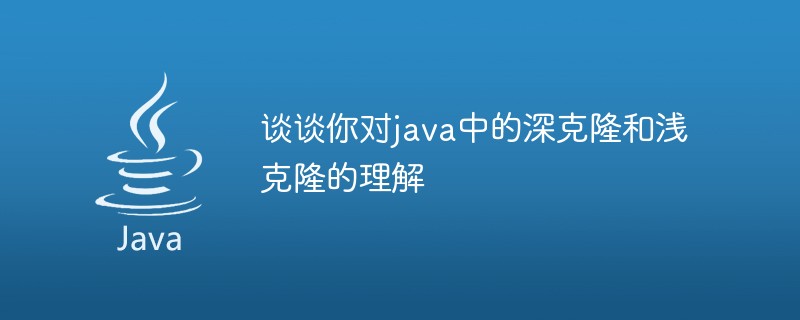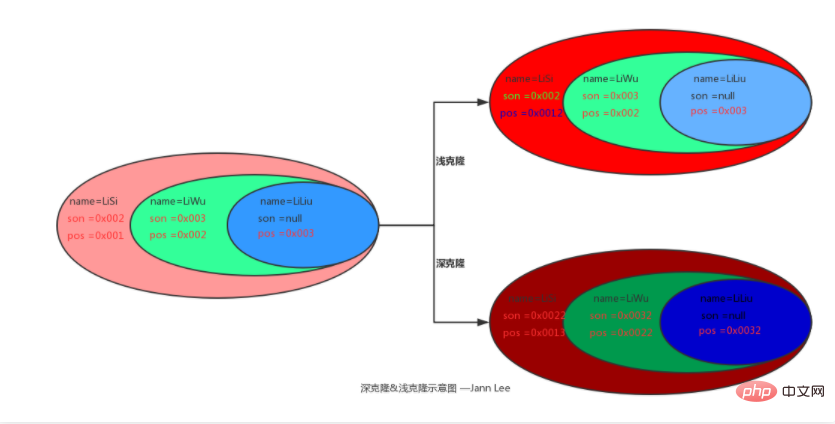 Java
Java
 JavaInterview questions
JavaInterview questions
 Talk about your understanding of deep cloning and shallow cloning in java
Talk about your understanding of deep cloning and shallow cloning in java
Talk about your understanding of deep cloning and shallow cloning in java
Jan 30, 2021 am 09:53 AM
Alibaba interviewer question:
Talk about your understanding of deep cloning and shallow cloning in java
Answer:
(Note: This article is about the difference and implementation method between deep cloning and shallow cloning?)
Talk is cheap
#I have encountered deep and shallow cloning (deep copy, shallow copy) more than once recently Question, except for the impression that there is a clone method, I am confused! ! ! Cloning (copying) is a common operation in Java to quickly obtain a copy of an object. Cloning is divided into deep cloning and shallow cloning.
Shallow clone: ??Create a new object. The properties of the new object are exactly the same as the original object. For non-basic type properties, they still point to the memory address of the object pointed to by the original properties.
Deep cloning: Create a new object, and other objects referenced in the attributes will also be cloned and no longer point to the original object address.
In short, both deep and shallow cloning will allocate a new area in the heap. The difference lies in whether the object referenced by the object attribute needs to be cloned (recursively).
Show you my picture
#pos: the address of the current object;
son: the address pointed to by the son attribute;
name: the name of the object Attributes.

(Related recommendations: java introductory tutorial)
Show you my code
#case1:
public class Son implements Serializable , Cloneable{ private String name; private Son son; public Son() { super();
} public String getName() { return name;
} public void setName(String name) { this.name = name;
} public Son getSon() { return son;
} public void setSon(Son son) { this.son = son;
} @Override
public String toString() { return super.toString();
} @Override
protected Object clone() throws CloneNotSupportedException { return super.clone();
}
}Test
public static void main(String[] args) throws Exception{ // 創(chuàng)建父親(LiLiu),兒子(LiWu),孫子(LiLiu)并關(guān)聯(lián)
Son father = new Son();
father.setName("LiSi");
Son son = new Son();
son.setName("LiWu");
Son grandSon = new Son();
grandSon.setName("LiLiu");
father.setSon(son);
son.setSon(grandSon); // 調(diào)用clone方法
Son fatherCopy = (Son) father.clone(); boolean flag1 = fatherCopy==father; boolean flag2 = fatherCopy.getSon() == son; boolean flag3 = fatherCopy.getSon().getSon() == grandSon; // 比較克隆后的地址
System.out.println(flag1);// false
System.out.println(flag2);// true
System.out.println(flag3);// true
// 比較Name
flag1= fatherCopy.getName()==father.getName();
flag2 = fatherCopy.getSon().getName() == son.getName();
flag3 = fatherCopy.getSon().getSon().getName() == grandSon.getName();
System.out.println(flag1);// true
System.out.println(flag2);// true
System.out.println(flag3);// true
//將對(duì)象寫到流里
ByteArrayOutputStream byteOut=new ByteArrayOutputStream();
ObjectOutputStream objOut=new ObjectOutputStream(byteOut);
objOut.writeObject(father); //從流里讀出來
ByteArrayInputStream byteIn=new ByteArrayInputStream(byteOut.toByteArray());
ObjectInputStream objInput=new ObjectInputStream(byteIn);
fatherCopy = (Son) objInput.readObject();
flag1= fatherCopy==father;
flag2 = fatherCopy.getSon() == son;
flag3 = fatherCopy.getSon().getSon() == grandSon;
System.out.println(flag1);// false
System.out.println(flag2);// false
System.out.println(flag3);// false
// 比較Name
flag1= fatherCopy.getName()==father.getName();
flag2 = fatherCopy.getSon().getName() == son.getName();
flag3 = fatherCopy.getSon().getSon().getName() == grandSon.getName();
System.out.println(flag1);// false
System.out.println(flag2);// false
System.out.println(flag3);// false}It is easy to see from the above code and running results that if the object implements Cloneable and overrides the clone method without performing any operations, calling clone is a shallow clone. Using object streams to write objects to the stream and then read them out is deep cloning.
Thinking: Since implementing the Cloneable interface and rewriting the clone interface can only perform shallow cloning. However, if the reference type attributes of the class (and the reference type attributes of the attribute) are shallow cloned, until there is no reference type attribute or the reference type attribute is null, a deep clone will be formed as a whole. Both the reference type attribute of the object and the application type attribute of the attribute implement Coloneable, override the clone method and call it in the clone method.
protected Object clone() throws CloneNotSupportedException {
Son result = (Son) super.clone(); if (son != null) {
result.son = (Son) son.clone();
} return result;
}Personally, I think that when choosing the deep cloning method, it should be based on the complexity of the object, such as whether the reference type attribute has multiple layers of reference type attribute relationships. If the object has only one or two layers of reference type attributes, it is more convenient to choose the method mentioned in the reflection. Otherwise, use object flow.
For more related interview questions, please visit: java interview questions and answers
The above is the detailed content of Talk about your understanding of deep cloning and shallow cloning in java. For more information, please follow other related articles on the PHP Chinese website!

Hot AI Tools

Undress AI Tool
Undress images for free

Undresser.AI Undress
AI-powered app for creating realistic nude photos

AI Clothes Remover
Online AI tool for removing clothes from photos.

Clothoff.io
AI clothes remover

Video Face Swap
Swap faces in any video effortlessly with our completely free AI face swap tool!

Hot Article

Hot Tools

Notepad++7.3.1
Easy-to-use and free code editor

SublimeText3 Chinese version
Chinese version, very easy to use

Zend Studio 13.0.1
Powerful PHP integrated development environment

Dreamweaver CS6
Visual web development tools

SublimeText3 Mac version
God-level code editing software (SublimeText3)

Hot Topics
 Java Optional example
Jul 12, 2025 am 02:55 AM
Java Optional example
Jul 12, 2025 am 02:55 AM
Optional can clearly express intentions and reduce code noise for null judgments. 1. Optional.ofNullable is a common way to deal with null objects. For example, when taking values ??from maps, orElse can be used to provide default values, so that the logic is clearer and concise; 2. Use chain calls maps to achieve nested values ??to safely avoid NPE, and automatically terminate if any link is null and return the default value; 3. Filter can be used for conditional filtering, and subsequent operations will continue to be performed only if the conditions are met, otherwise it will jump directly to orElse, which is suitable for lightweight business judgment; 4. It is not recommended to overuse Optional, such as basic types or simple logic, which will increase complexity, and some scenarios will directly return to nu.
 How to iterate over a Map in Java?
Jul 13, 2025 am 02:54 AM
How to iterate over a Map in Java?
Jul 13, 2025 am 02:54 AM
There are three common methods to traverse Map in Java: 1. Use entrySet to obtain keys and values at the same time, which is suitable for most scenarios; 2. Use keySet or values to traverse keys or values respectively; 3. Use Java8's forEach to simplify the code structure. entrySet returns a Set set containing all key-value pairs, and each loop gets the Map.Entry object, suitable for frequent access to keys and values; if only keys or values are required, you can call keySet() or values() respectively, or you can get the value through map.get(key) when traversing the keys; Java 8 can use forEach((key,value)->
 How to fix java.io.NotSerializableException?
Jul 12, 2025 am 03:07 AM
How to fix java.io.NotSerializableException?
Jul 12, 2025 am 03:07 AM
The core workaround for encountering java.io.NotSerializableException is to ensure that all classes that need to be serialized implement the Serializable interface and check the serialization support of nested objects. 1. Add implementsSerializable to the main class; 2. Ensure that the corresponding classes of custom fields in the class also implement Serializable; 3. Use transient to mark fields that do not need to be serialized; 4. Check the non-serialized types in collections or nested objects; 5. Check which class does not implement the interface; 6. Consider replacement design for classes that cannot be modified, such as saving key data or using serializable intermediate structures; 7. Consider modifying
 Comparable vs Comparator in Java
Jul 13, 2025 am 02:31 AM
Comparable vs Comparator in Java
Jul 13, 2025 am 02:31 AM
In Java, Comparable is used to define default sorting rules internally, and Comparator is used to define multiple sorting logic externally. 1.Comparable is an interface implemented by the class itself. It defines the natural order by rewriting the compareTo() method. It is suitable for classes with fixed and most commonly used sorting methods, such as String or Integer. 2. Comparator is an externally defined functional interface, implemented through the compare() method, suitable for situations where multiple sorting methods are required for the same class, the class source code cannot be modified, or the sorting logic is often changed. The difference between the two is that Comparable can only define a sorting logic and needs to modify the class itself, while Compar
 How to parse JSON in Java?
Jul 11, 2025 am 02:18 AM
How to parse JSON in Java?
Jul 11, 2025 am 02:18 AM
There are three common ways to parse JSON in Java: use Jackson, Gson, or org.json. 1. Jackson is suitable for most projects, with good performance and comprehensive functions, and supports conversion and annotation mapping between objects and JSON strings; 2. Gson is more suitable for Android projects or lightweight needs, and is simple to use but slightly inferior in handling complex structures and high-performance scenarios; 3.org.json is suitable for simple tasks or small scripts, and is not recommended for large projects because of its lack of flexibility and type safety. The choice should be decided based on actual needs.
 Outlook shortcut for new email
Jul 11, 2025 am 03:25 AM
Outlook shortcut for new email
Jul 11, 2025 am 03:25 AM
How to quickly create new emails in Outlook is as follows: 1. The desktop version uses the shortcut key Ctrl Shift M to directly pop up a new email window; 2. The web version can create new emails in one-click by creating a bookmark containing JavaScript (such as javascript:document.querySelector("divrole='button'").click()); 3. Use browser plug-ins (such as Vimium, CrxMouseGestures) to trigger the "New Mail" button; 4. Windows users can also select "New Mail" by right-clicking the Outlook icon of the taskbar
 Java method references explained
Jul 12, 2025 am 02:59 AM
Java method references explained
Jul 12, 2025 am 02:59 AM
Method reference is a way to simplify the writing of Lambda expressions in Java, making the code more concise. It is not a new syntax, but a shortcut to Lambda expressions introduced by Java 8, suitable for the context of functional interfaces. The core is to use existing methods directly as implementations of functional interfaces. For example, System.out::println is equivalent to s->System.out.println(s). There are four main forms of method reference: 1. Static method reference (ClassName::staticMethodName); 2. Instance method reference (binding to a specific object, instance::methodName); 3.
 Understanding the Java volatile Keyword Usage
Jul 12, 2025 am 01:50 AM
Understanding the Java volatile Keyword Usage
Jul 12, 2025 am 01:50 AM
The volatile keyword in Java often feels a bit abstract, especially for those who are new to concurrent programming. In fact, its function is very clear: to ensure the visibility of variables between multiple threads. That is to say, when one thread modifies the variable value modified by volatile, other threads can see the change immediately. It is not a master key to solve all concurrency problems, but it is very useful in some scenarios. Let’s take a look at how to use it and where it is suitable for use. When do you need to use volatile? The most typical application scenario is the status flag, such as controlling whether the thread continues to run: privatevolatilebooleanrunning=true;





